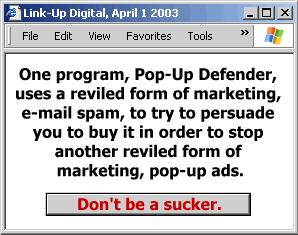 The
metaphor comparing the business world to a battleground
is often overused. But it’s not trite to say that
a fierce struggle is raging between Web advertisers
trying to capture your attention and Web consumers who
want to surf unfettered. The
metaphor comparing the business world to a battleground
is often overused. But it’s not trite to say that
a fierce struggle is raging between Web advertisers
trying to capture your attention and Web consumers who
want to surf unfettered.
The stakes are high. With the collapse of the dot-com
economy based largely on the simple, unobtrusive banner
ad, Web publishers are desperately trying to come up
with other, viable, business models.
If they fail, if Web publishers can’t bring in
adequate revenue, the Internet won’t achieve its
potential of near-instant linking individuals and organizations
with the information they need and the entertainment
they want.
To entice you to visit their sites and buy their products,
Web advertisers are resorting to ever more intrusive
and interruptive technologies. These include:
- Pop-up ads, which appear in a new browser
window when you arrive at a Web page and block part
of that page or all of that page (interstitials).
- Pop-under ads, which load in the background
under the current page and appear when you close that
page.
- Spawning results in multiple browser windows
that open, one after another, when you enter or exit
a site.
- Mouse trapping disables your ability to
click back to a previous page or to use your mouse
to exit your browser.
- Pop-up spam ads pop up on your screen
if you’re connected to the Internet, regardless
of whether you have your Web browser running.
Web advertisers are using these techniques in ever-greater
numbers. Almost one out of three of the largest Web
sites in the U.S. now use pop-up and pop-under ads,
according to a survey by Cyveillance, an Internet services
consulting firm. About 5 percent use mouse trapping.
And 1.4 percent go so far as changing your home page
or favorites list.
Many of these techniques were developed by programmers
of adult Web sites, who have no shame. Some mainstream
Web sites, having no shame, are now doing the same.
Web surfers are fighting back. Some are using ad-blocking
software, sometimes called “ad killers.”
These programs are widely available as inexpensive “shareware”
or “freeware,” typically from individual
entrepreneurs. Popular choices include AddSubtract and
Guard-IE Popup Killer and Privacy Suite, available from
download sites such as CNET’s Download.com, at
http://www.download.com.
One program, Pop-Up Defender, uses a reviled form of
marketing, e-mail spam, to try to persuade you to buy
it in order to stop another reviled form of marketing,
pop-up ads. Don’t be a sucker. EarthLink subscribers
get the use of a pop-up blocking tool for free.
Ad-blocking software is beginning to become mainstream.
For some time, utility powerhouse Symantec, at http://www.symantec.com,
has bundled an ad-blocking component with its Norton
Internet Security. More recently, Web browsers such
as Mozilla, at http://www.mozilla.org,
and the newly released Apple Safari, at http://www.apple.com/safari,
have begun to offer this capability, preventing consumers
from having to use a third-party tool.
You’d think advertisers would get the message.
But reports indicate that some sites are upping the
ante, resorting to technologies that disable all or
part of their sites if they detect you’re using
ad-blocking software.
Bad move, says Gary Stein, an analyst specializing in
Internet marketing at Jupiter Research, a market research
firm headquartered in New York City. “In a war
between advertisers and consumers, consumers will win,”
he says. “An angry consumer won’t be a customer.”
Recognizing that the Internet is all about freedom of
choice, some enlightened Web publishers are adopting
different strategies. America Online now bans third-party
pop-up ads (but not its own). iVillage, at http://www.ivillage.com,
bans all pop-ups. Salon.com, at http://www.salon.com,
bans all ads if you subscribe ($30/year), or you can
choose to view the site for free, including its pop-up
and banner ads.
Some Web publishers will be tempted to use “integrated
advertising” to make ad messages seem like regular
content or “contextual advertising” to tailor
ads to individuals by tracking their surfing habits.
Making ads more “relevant” in these ways,
however, is a slippery slope, raising thorny ethical
and privacy issues. Blurring the lines between editorial
and advertising is deceitful unless sites clearly label
the sponsored content, as print publications do with
advertorials. And using “spyware” that tracks
what you do online risks creating a huge consumer backlash.
A better approach here is to ask surfers to voluntarily
answer questions.
What advertisers need to do in general, says Stein,
is what they’ve always done best: Be creative.
Instead of hijacking consumers’ surfing time,
create interesting ads with fun or substantive content
that people want to see.
Reid Goldsborough
is a syndicated columnist and author of the book Straight
Talk About the Information Superhighway. He can be
reached at reidgold@comcast.net
or http://www.reidgoldsborough.com.
|